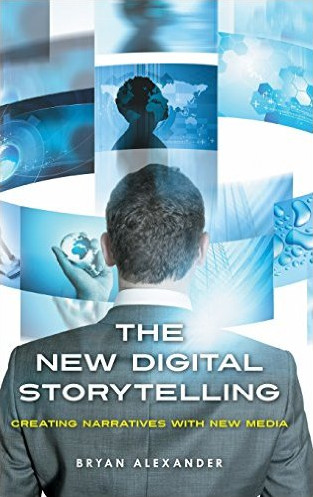Bryan Alexander on Mobile Storytelling

In Chapter 9 of his book The New Digital Storytelling, Bryan Alexander considered the possibilities for mobile devices like smartphones, e-readers, and tablets as perhaps “the ultimate digital storytelling device.” Mobile phones, in particular, have become “the most popular computing platform in the world” (p139). Not only have phones made digital resources available to more people around the globe than larger more expensive computers, they’ve also made digital access a more constant part of everyday life for their owners. When creating or adapting stories for mobile devices, however, digital storytellers like historians need to make the most of the platform’s strengths and limitations.
The defining characteristics of mobile devices are their portability, facilitated by small size, and their wireless network connections. Together these attributes allow for “ubiquitous computing,” but they also necessitate a small screen and simplified user interface compared to a desktop or laptop. Rather than regarding these factors as obstacles to effective storytelling, Alexander argues that they make familiar digital stories, whether in the form of games, social media, or texts, “accelerated, amplified, and somewhat mutated” (p142). Mobile storytellers need to streamline visual design and menus to make the most of limited screen space while also considering how on-the-go use of mobile devices might require delivering stories in a more fast-paced or bite-sized format.
Alexander considered different means of packaging and delivering stories for mobile devices, either as apps or mobile-optimized websites. I find websites the more accessible delivery format. It is true that apps can allow advanced features or offline functionality that are hard to implement in a website, but they must also be installed before use, a barrier to casual on-the-go engagement. Furthermore, apps are platform-specific, so developers have to create multiple apps if they hope to reach users of many kinds of devices. Mobile-optimized websites, however, can be accessed immediately with the default browser on just about any computing platform and can provide much of the same storytelling capability of an app.
As an example, consider a common use of mobile storytelling in the history field: place-based applications that link historic images and texts to maps, allowing mobile users to discover the stories of the locations they visit with their devices. An online search reveals several apps with this functionality, including both global social apps like What Was There and History Pin to specific city apps like Street Museum Londinium or Past Chicago. Of these examples, however, What Was There, Londinium, and Past Chicago, are only available as iPhone or iPad apps — making their stories inaccessible on Android devices, which have a far larger market share. What Was There does at least provide access to its content via a website as well as an iOS app, but the website is not optimized for mobile screens, making it awkward to use without constantly zooming and scrolling around pages that are too big for a phone screen.
HistoryPin, by contrast, provides all of its functionality through an increasingly mobile-friendly website. In 2015, it announced that it was discontinuing its iOS and Android apps to instead focus its resources toward improving its mobile web design, which includes condensed menus and responsive, flexible pages that adjust seamlessly to width of a viewer’s screen. This makes its content readily available to users no matter what platform they use, and represents the better technological approach to delivering mobile stories.
Not all mobile storytelling requires a highly technical delivery format, of course. One of the most interesting forms of mobile storytelling discussed by Alexander was the rise of keitai shosetsu, or cell-phone novels, beginning in Japan. These stories are simple low-tech text files, but they use an innovative writing style that makes reading on a phone more pleasurable. Consider the following excerpt from a birthday party scene in the English cell phone novel Secondhand Memoriesby Takatsu:
I closed my eyes for a moment and pretended to make a wish.
Oddly enough, nothing came to mind.
I was content with life.
I just hoped it would stay this way.Maybe I should have made a wish.
I blew out the candles and they whooped.
As this excerpt illustrates, the cell phone novel favors short sentences and frequent poetry-like line breaks that both declutter small screens while also creating poignant short scenes that, as Alexander puts it, can be read “in the interstices of daily life, in between activities demanding our attention” (p 143). Given that history remains above all else a textual discipline, historians too should consider mobile storytelling not only in terms of complex, interactive apps and websites, but also more fundamentally about how mobile devices can be an invitation to improve the craft of historical writing to be more lucid, concise, and evocative for the mobile attention span.
Reviewed Reading: Alexander, Bryan. “Mobile Devices: The Birth of New Designs for Small Screens.” In The New Digital Storytelling: Creating Narratives with New Media. Santa Barbara, Cal.: Praeger, 2011. 139-150.